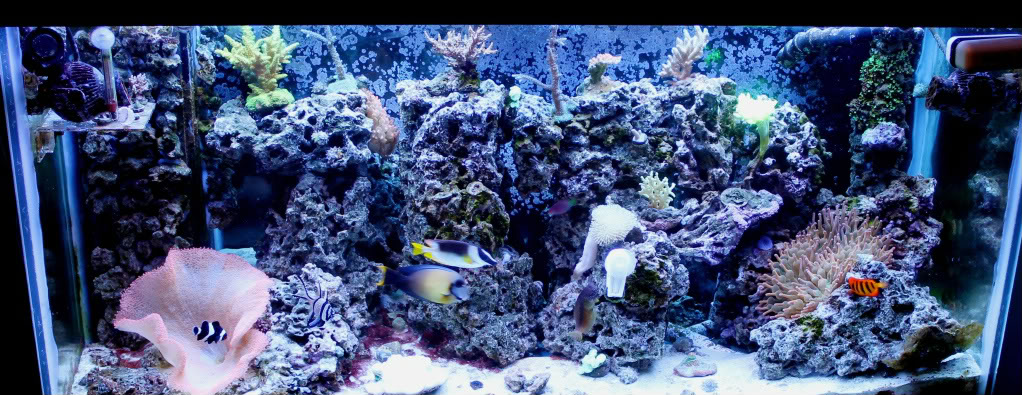
Converting a Freshwater Aquarium into a Saltwater Aquarium
So after keeping a freshwater aquarium, you now have decided to try out a marine aquarium.While there are many similarities between the two, there are also some differences.Marine is not any harder to set-up or maintain when compared to freshwater, but there is a little more to it. The amount of success you will get with your marine aquarium will be in direct proportion to the amount of research you complete beforehand. This article is meant guide you through that assuming you have only just started. There will be a lot of information contained in the below links so don’t feel overwhelmed.I would suggest reading through them, take your time, and take things one step at a time. There is nothing overly difficult here.
Once you have some basic and little more than basic information, you can now plan your set-up. These links can help with that part:
- https://www.reefaquarium.com/2012/some-of-the-must-knows-for-beginners/
- https://www.reefaquarium.com/2013/10-most-common-beginner-mistakes/
- https://www.reefaquarium.com/2012/setting-up-your-first-marine-aquarium-2/
- https://www.reefaquarium.com/2012/the-importance-of-water-flow-and-movement-2/
- https://www.reefaquarium.com/2012/some-sump-basics/
- https://www.reefaquarium.com/2012/aquarium-plumbing-basics/
- https://www.reefaquarium.com/2012/how-to-drill-a-aquarium/
With some information and a plan in mind, you are now ready to start converting your freshwater aquarium into a marine aquarium. First step is to rehome your current fresh water fish. I would suggest seeing if you could return them to your local fish store. That would typically be one of the better options if you do not know someone who is will to take the fish from you. You could maybe even receive some store credit, but that would depend on the store’s policies for this.
Next step would be to empty the tank completely, and remove the décor and substrate, followed by giving the tank and all equipment a very good cleaning with some vinegar water. I would also suggest taking down your filtration and give it a thorough cleaning in tap water. The beneficial bacteria that lives and thrives in your fresh water filters will not transfer over to a saltwater environment. Due to the different minerals and mineral concentrations between fresh water and salt water, practically all of the fresh water bacteria will be killed off due to osmotic shock if you were to place them in a marine water environment. You will also need to replace the substrate that was used in your fresh water tank with substrate that is meant for a marine environment. A good marine substrate will leach out minerals like calcium which will help your pH to remain more stable in your marine set-up.
Next would be to add your substrate to the aquarium. I would not recommend live sand. I good quality marine substrate is all you need.
After that, fill your aquarium with premixed salt water with a salinity of between 1.025 to 1.026. The below links may be of help:
Next step is to set-up your filtration and cycle your aquarium. The below links will help with that:
- https://www.reefaquarium.com/2012/cycling-a-marine-aquarium/
- https://www.reefaquarium.com/2013/common-approaches-to-filtration-in-marine-aquariums/
- https://www.reefaquarium.com/2013/some-algae-scrubber-basics/
- https://www.reefaquarium.com/2013/curing-rock-for-marine-aquariums/
- https://www.reefaquarium.com/2013/selecting-a-new-skimmer/
You can add your lighting at any point, but I would recommend adding it after your tank is cycled in order to help prevent algaes. In the past, I used the same T5HO light fixture but changed the bulbs to a more appropriate color temp and an actinic bulb. This approach give you more appropriate lighting to a marine set-up and will help avoid nasty algaes. Typical marine lighting will have a color temp of 12,000K to 22,000K. Keep in mind, there are different requirements for reef aquariums as compared to FOWLR. Some of the below links can help pick out marine bulbs or a new light fixture.
- http://www.aquaticcommunity.com/aquariumforum/showthread.php?t=116203
- https://www.reefaquarium.com/2012/reef-lighting-2/
Once your cycle has completed, you need to test your water for about a week or two to make sure everything is in line. The below will help you identify what you need to test for and the ideal parameters to maintain.
Once you have confirmed the parameters are stable, you can start to slowly add your fish. The below information can help with deciding what fish to start with and the importance of using a quarantine tank.
- https://www.reefaquarium.com/2012/good-starter-fish-and-clean-up-crew-options/
- https://www.reefaquarium.com/category/fish/
- https://www.reefaquarium.com/2012/quarantining-new-additions/
Now that your set-up is up and running with at least your first few tank inhabitants, you will now need to focus on ongoing routine maintenance. The below link will help with that.
I hope this will be able to help you through the move from freshwater into saltwater
Hi!
I think your site is great! I have used a lot of tips from here setting up my first reef tank. Well actually it was converted from fresh water. And I was quite successful till I had to move! Well, now that I have moved into my own place, I am planing a big one! Having a lot of experience, since age 7! I just can’t figure out though, how to stack up the live rocks/rocks, specially to place the plate corals!? Can u please advise? I am planing to build an L-shaped tank with my living room columns, dimmensions will be 3.5’x3.5’L x4′ high. I want a cluster of green plate corals in the background!
Thank you,
Kind regards,
Atish.
You can use a type of coral putty to make your rocks more secure and solid when you stack them. The link below shows just one example of what I am talking about
http://www.drsfostersmith.com/product/prod_display.cfm?pcatid=3962
Hi. I have several Aqua One AR850s that I have been running as tropical freshwater, but am considering converting them to marine. Is the overhead biofilter that comes as part of the setup suitable for marine?
I know I will have to change the lighting from the T8 to T5, and likely install a sump in the cabinet underneath to have a protien skimmer.
I would suggest using live rock for your biological filteration and use that built in filter for some chemical filteration (like carbon or phosphate remover). unless you want some corals, you should be able to use the existing T8 fixture with marine bulbs.